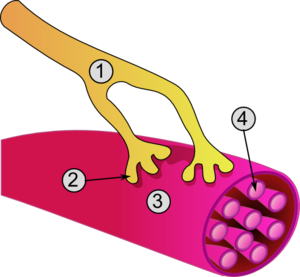Myocyte
type of cell found in muscle tissue
A myocyte (also known as a muscle cell)[1] is the type of cell found in muscle tissue.

1. Axon
2. Neuromuscular junction
3. Muscle fiber (Myocyte)
4. Myofibril
Myocytes are long, tubular cells. They develop from myoblasts to form muscles in a process called myogenesis.[2]
There are various specialized forms of myocytes: cardiac, skeletal, and smooth muscle cells. They have different structures. The striated or striped cells of cardiac and skeletal muscles are called muscle fibers.[1]
Cardiomyocytes are the muscle fibres which form the chambers of the heart. They have a single central nucleus.[3] Skeletal muscle fibers help support and move the body. They usually have peripheral nuclei.[4][5]
Smooth muscle cells control involuntary movements such as the peristalsis contractions in the oesophagus and stomach.
References
change- ↑ 1.0 1.1 Daniel Albert et al 2012. Dorland's illustrated medical dictionary, 32nd ed, p321 & 697. Saunders/Elsevier Philadelphia, PA. ISBN 978-1-4160-6257-8
- ↑ Myocytes at the US National Library of Medicine Medical Subject Headings (MeSH)[1]
- ↑ "Muscle tissues". Archived from the original on 2015-10-13. Retrieved 2018-04-29.
- ↑ Scott, W; Stevens, J; Binder-Macleod, SA (2001). "Human skeletal muscle fiber type classifications". Physical Therapy. 81 (11): 1810–1816. doi:10.1093/ptj/81.11.1810. PMID 11694174. Archived from the original on 2015-02-13.
- ↑ "Does anyone know why skeletal muscle fibers have peripheral nuclei, but the cardiomyocytes not? What are the functional advantages?".